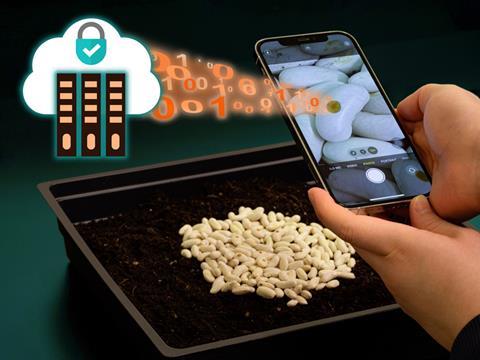
Average crop yields in Africa are consistently far below those expected, and one significant reason is the prevalence of counterfeit seeds whose germination rates are far lower than those of the genuine ones. There have been many attempts to prevent this counterfeiting through tracking labels, but none have proved effective.
Now a team of MIT researchers has come up with a tiny, biodegradable tag that can be applied directly to the seeds themselves, providing a unique, randomly created code that cannot be duplicated, they claim.
The new system, which uses minuscule dots of silk-based material, each containing a unique combination of different chemical signatures, is described in the journal Science Advances in a paper by MIT’s dean of engineering Anantha Chandrakasan; professor of civil and environmental engineering Benedetto Marelli; postdoc Hui Sun; and graduate student Saurav Maji.
With the problem of counterfeiting an enormous one globally, affecting everything from drugs to luxury goods, many different systems have been developed to try to combat this. But there has been less attention to the problem in the area of agriculture, even though the consequences can be severe, says the research team. The World Bank estimates that as much as half of all seeds sold in some African countries are fake, accounting for crop production that is far below potential.
Marelli explains that a key to the new system is creating a randomly-produced physical object whose exact composition is virtually impossible to duplicate. The labels they create “leverage randomness and uncertainty in the process of application, to generate unique signature features that can be read but that cannot be replicated,” he says.
What they’re dealing with, Sun adds, “is the very old job of trying not to get your stuff stolen. And you can try as much as you can, but eventually somebody is always smart enough to figure out how to do it.”
The idea of an “unclonable” code was originally developed as a way of protecting the authenticity of computer chips, explains Chandrakasan. “In integrated circuits, individual transistors have slightly different properties coined device variations and you could then use that variability and combine it with higher-level circuits to create a unique ID for the device,” he explains. The concept is based on what are known as physically unclonable functions, or PUFs.
The team decided to try to apply that PUF principle to the problem of fake seeds and the use of silk proteins was a natural choice because the material is not only harmless to the environment but also classified by the Food and Drug Administration in the “generally recognized as safe” category, so it requires no special approval for use on food products.
“You could coat it on top of seeds,” Maji says, “and if you synthesize silk in a certain way, it will also have natural random variations. So that’s the idea, that every seed or every bag could have a unique signature.”
“The challenge was what type of form factor to give to silk,” Sun says, “so that it can be fabricated very easily.” They developed a simple drop-casting approach that produces tags that are less than 0.1” (2.5mm) in diameter. The second challenge was to develop “a way where we can read the uniqueness in a very high throughput and easy way.”
Marelli explains, “Eventually we found a way to add a colour to these microparticles so that they assemble in random structures.” The resulting unique patterns can be read out, not only by a spectrograph or a portable microscope, but even by an ordinary cellphone camera with a macro lens. This image can be processed locally to generate the PUF code and then sent to the cloud and compared with a secure database to ensure the authenticity of the product.
The number of possible permutations that could result from the way they mix four basic types of coloured silk nanoparticles is astronomical. “We were able to show that with a minimal amount of silk, we were able to generate 128 random bits of security,” Maji says. “So this gives rise to 2 to the power 128 possible combinations, which is extremely difficult to crack given the computational capabilities of the state-of-the-art computing systems.”
Some additional work will be needed to make this a practical commercial product, Chandrakasan confirms. “There will have to be a development for at-scale reading” via smartphones. But the principle now shows a clear path to the day when “a farmer could maybe take some random seeds in a particular batch and verify them,” he says.
This article was created in collaboration with AIPIA (the Active and Intelligent Packaging Industry Association). For a full update on active and intelligent packaging, come along to the AIPIA World Congress (co-organized by Packaging Europe) in Amsterdam on 14-15 November. The only smart packaging event covering the entire technology spectrum, the World Congress is a meeting place for the global active and intelligent packaging industry where brand owners, innovators, and other stakeholders can network and see and discuss the latest trends and innovations. Register to attend here.











No comments yet